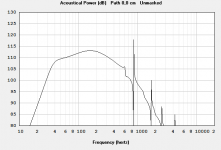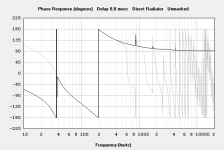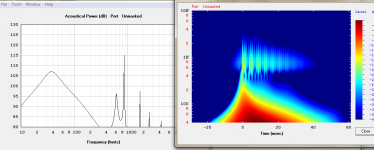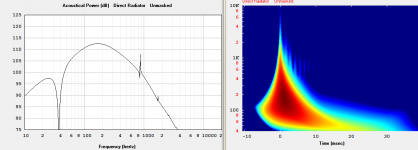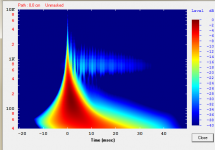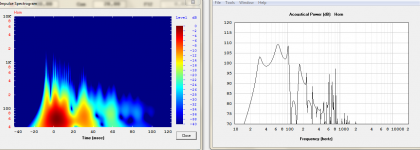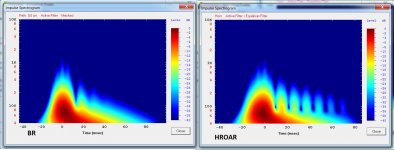Thanks for the links. FFT is a tool to analyse signals when looking at the time domain gets scary...etc... 😉 I still don't see the problem when it comes to how transients are reproduced by the speaker system?FFT is not very useful on nonlinear signals such as music from real life instruments. Sure you can get an approximation of the harmonic content, but it is only a crude approximation.
Music is not composed of simple or complex sets of sine waves. IF you have an infinite bandwidth (few amps or speakers can even play a slow 100 megahertz signal) then you can compose a square wave from an infinite set of sine waves.
Last edited:
if your system (drivers + enclosures + amplifyer ::: low + mid + hi) is able to perfectly folow voltage signal trace and produce sound waves accordly, then it's able to proper reproduce trasients.
Probably there are transients that there isn't real system able to reproduce, so someone needs to pick up the best trade-off possible
Probably there are transients that there isn't real system able to reproduce, so someone needs to pick up the best trade-off possible
I still don't see the problem when it comes to how transients are reproduced by the speaker system?
The bassreflex is a acoustic sinewave resonator that lags at least one wavelength behind the driver. Since the acoustic sinewave resonator does not reproduce nonlinear non-sinusoidal (steep transients, chockwaves, or heavily modulated "jagged" waveforms) the port response should be considered noise and not signal (since it will not reproduce real world signals - but will use the energy from the driver to drive a more or less pure sine wave generating oscillation). I know this is at the lower end of the spectrum and our ears are not as good at differentiating noise from signal in the bass spectrum.
It will however react to a steep transient with a low amplitude sinewave resonans lagging the driver. This will not reproduce a steep transient chockwave from a drum or a plucked bass guitar. It will reproduce the midbass reasonable well, but the bass (the large displacement of air creating the chockwave) will due to the lag and the gradual buildup during several wavelengths and the rounding of the transient into a sinewave, severly muffle and damp the transient and the physical and tactile chockwave. And the high Q sine wave oscillator will once it reaches peak displacement keep on resonating several wavelengths after the signal is over. All this is easy to hear when you play a short transient drum signal through a bass reflex box. It gives a first short midbass and midrange transient without much physical and tactile energy, followed by a resonant decay that does not belong to the original signal.
This is not what I would call "good transient response".
A large front loaded horn will reproduce the large displacement chockwave from the leading edge transient with a very physical and tactile impact with no gradual buildup of sinewave resonans and no overshooting decay of any sinewave resonans from an excited oscillator. It will reproduce a short chockwave and the natural decay of the signal without lagging and without adding a resonant noise.
The ROAR, H-ROAR or tapped horns might not be as good as true full sized front loaded horns, but they are still much better at reproducing transient nonlinear and non-sinuoidal signals then bass reflex.
You can't compensate the poor transient response of a loosly coupled sinewave oscillator with a midrange and tweeter, as the loosly coupled sinewave oscillator (BR) does not do its part in creating the large and imidiate displacement needed to create the chockwave.
The way I see it, the problem with BR, along with other resonant filters, is the group delay which screws up the time coherence with the rest of the system and hence makes a mess of the transient response of the system. Depending on what you mean by steep transients or jagged waveforms, and even shockwaves they are not wholly a product of the woofer, that's all I'm querying really.
Depending on what you mean by steep transients or jagged waveforms, and even shockwaves they are not wholly a product of the woofer, that's all I'm querying really
(my underlining)
I agree.
Cheers,
Johannes
Hornresp is your friend :
pic 1 : a simple not optimised bassreflex response sim...
pic 2 : port vs direct response...
pic 3 : phases (centered at 0ms delay) good tracking on useful bandwith
pic 4 : port spectrogram pretty nice
pic 5 : direct spectrogram
pic 6 : total spectrogram
We're talking about some complex stuff, and anything can be tell wrong if without precision. I know it because i'm somewhat someone really approxmiative 😀
For example, reading "a acoustic sinewave resonator that lags at least one wavelength behind the driver" is scary :
What bandwith are we talking about ? What frequency ? Is there any mean to fight this ?
=> just a good practice for bass reflex : tune lower than needed bandwith.
The bad stuff about reflex are port compression, chuffing (need big port for higher power), resonnances (stub can be used to fight this), as for all sub high pass slope needs to be well damped, and as said before, tuning lower is better. Oh, and i forgot, since there's no back chamber to help voicecoil of non symetrical motor keeping in place, it's better using speaker with stiff suspension, or it will give offset at high volume so distortion and compression (that someone else said, is often considered as loudness ^^)
EDIT : I've already shown that "lagging" port, is just a question of damping/slope tuning => something traditionnally called alignement, very well know stuff, lol.
And front chamber/port is just for TH (and road/6th/8th) where front and back wave blend, so that if they're not in phase, you cannot mesure it, lol. (In akabak it can be simmed of course)
Whereas for bass-reflex, both wave (more pressure than wave in lower range) blend in room. I see no problem.
Front loaded just add low pass effect really useful for filtering higher order harmonics.
Correct me if i'm wrong, thanks !
pic 1 : a simple not optimised bassreflex response sim...
pic 2 : port vs direct response...
pic 3 : phases (centered at 0ms delay) good tracking on useful bandwith
pic 4 : port spectrogram pretty nice
pic 5 : direct spectrogram
pic 6 : total spectrogram
We're talking about some complex stuff, and anything can be tell wrong if without precision. I know it because i'm somewhat someone really approxmiative 😀
For example, reading "a acoustic sinewave resonator that lags at least one wavelength behind the driver" is scary :
What bandwith are we talking about ? What frequency ? Is there any mean to fight this ?
=> just a good practice for bass reflex : tune lower than needed bandwith.
The bad stuff about reflex are port compression, chuffing (need big port for higher power), resonnances (stub can be used to fight this), as for all sub high pass slope needs to be well damped, and as said before, tuning lower is better. Oh, and i forgot, since there's no back chamber to help voicecoil of non symetrical motor keeping in place, it's better using speaker with stiff suspension, or it will give offset at high volume so distortion and compression (that someone else said, is often considered as loudness ^^)
EDIT : I've already shown that "lagging" port, is just a question of damping/slope tuning => something traditionnally called alignement, very well know stuff, lol.
And front chamber/port is just for TH (and road/6th/8th) where front and back wave blend, so that if they're not in phase, you cannot mesure it, lol. (In akabak it can be simmed of course)
Whereas for bass-reflex, both wave (more pressure than wave in lower range) blend in room. I see no problem.
Front loaded just add low pass effect really useful for filtering higher order harmonics.
Correct me if i'm wrong, thanks !
Attachments
Last edited:
A well damped port with low Q wide bandwidth port response, low tuned and with a generous cross section area is better then the opposite...
If you use a high Bl, low Mms, low Qts driver to drive this it will be even better.
But if you keep up this changing trend, you get a compression driver driving a horn or a quarter wave resonator. 😀
A small box BR with a large cross section well damped long and low(ish) Q port is on its way to turn into a quarter wave resonator, so its no wonder it will sound and behave better.
If you use a high Bl, low Mms, low Qts driver to drive this it will be even better.
But if you keep up this changing trend, you get a compression driver driving a horn or a quarter wave resonator. 😀
A small box BR with a large cross section well damped long and low(ish) Q port is on its way to turn into a quarter wave resonator, so its no wonder it will sound and behave better.
TH are limited to subwoofer duty, and need higher order low pass due to noisy out of band. Bass-reflex can be filtered with lower order low pass. It just a matter of trade-off. Crossing well subwoofers is a hard part for most of people.
A well damped port with low Q wide bandwidth port response, low tuned and with a generous cross section area is better then the opposite...
If you use a high Bl, low Mms, low Qts driver to drive this it will be even better.
But if you keep up this changing trend, you get a compression driver driving a horn or a quarter wave resonator. 😀
A small box BR with a large cross section well damped long and low(ish) Q port is on its way to turn into a quarter wave resonator, so its no wonder it will sound and behave better.
It is just called alignement. Nothing fancy. And that is the contrary too low qts/mms/too much motor and again, it become undamped...
TH segments are resistive and damp too...tuning them allow tweaking damping effect. For bass reflex, it just need to choose the good sub for the desired target...
And still we have to not forget that EQuing tweaks damping too...
"it will be better" : There's pro, and con.
TH allow more tweak, higher order, venting the voicecoil, front chamber allow acoustic low pass. But more complex, harder to cross, needs measuring better speakder, heavier boxes, cannot be tune if construction error have been made, and ask for harder cone.
Last edited:
Wonderfulaudio: i have asked you how the delay connects to the graph. Since you do not reply, explain, but give again empty misleading statement i suppose you may not have understood it yourself? 😀
Pre filtered and post filtered, both are in phase, the graph is not showing the delay that much is clear.
I dont see GD (or can explain) because I see phase instead. If phase changes and is reversed by a filter etc then the signal is considered preserved.
The phase inversion of 180 degrees of bass reflex alignment can easily be reversed by an all-pass filter of matching Q and F.
You are unable to split the high frequency (transients) from low frequency. Time domain cannot help us understand any better. Frequency domain can but it is being rejected. So its difficult to converge and move ahead.The bassreflex is a acoustic sinewave resonator that lags at least one wavelength behind the driver. Since the acoustic sinewave resonator does not reproduce nonlinear non-sinusoidal (steep transients, chockwaves, or heavily modulated "jagged" waveforms) the port response should be considered noise and not signal (since it will not reproduce real world signals - but will use the energy from the driver to drive a more or less pure sine wave generating oscillation). I know this is at the lower end of the spectrum and our ears are not as good at differentiating noise from signal in the bass spectrum.
It will however react to a steep transient with a low amplitude sinewave resonans lagging the driver. This will not reproduce a steep transient chockwave from a drum or a plucked bass guitar. It will reproduce the midbass reasonable well, but the bass (the large displacement of air creating the chockwave) will due to the lag and the gradual buildup during several wavelengths and the rounding of the transient into a sinewave, severly muffle and damp the transient and the physical and tactile chockwave. And the high Q sine wave oscillator will once it reaches peak displacement keep on resonating several wavelengths after the signal is over. All this is easy to hear when you play a short transient drum signal through a bass reflex box. It gives a first short midbass and midrange transient without much physical and tactile energy, followed by a resonant decay that does not belong to the original signal.
This is not what I would call "good transient response".
A large front loaded horn will reproduce the large displacement chockwave from the leading edge transient with a very physical and tactile impact with no gradual buildup of sinewave resonans and no overshooting decay of any sinewave resonans from an excited oscillator. It will reproduce a short chockwave and the natural decay of the signal without lagging and without adding a resonant noise.
The ROAR, H-ROAR or tapped horns might not be as good as true full sized front loaded horns, but they are still much better at reproducing transient nonlinear and non-sinuoidal signals then bass reflex.
You can't compensate the poor transient response of a loosly coupled sinewave oscillator with a midrange and tweeter, as the loosly coupled sinewave oscillator (BR) does not do its part in creating the large and imidiate displacement needed to create the chockwave.
Also if BR has a resonator then the horn too has a resonator, and thats even a stronger resonator. Why that should not have ringing, either pre or post.
Since you have both a BR and a horn to compare, maybe you could do a small comparison. Bandwidth limit the drum sound so that it is within the bandwidth of both the BR as well as Horn. Now play them on both and observe any difference. Only sub, no mid and no highs.
Last edited:
I think he understands that....You are unable to split the high frequency (transients) from low frequency. Time domain cannot help us understand any better. Frequency domain can but it is being rejected. So its difficult to converge and move ahead.
I appreciate how sometimes it can be hard to accept how signals sum(my underlining)
I agree.
Cheers,
Johannes
Here you're own definition of tightness. Lot of character of course. Like a guitar speaker. Should be pleasant, it must have something to do with low order harmonics. Powerful, of course. Dynamic, hell yes. Neutral, no way. It's heavily resonnant.View attachment 755182
Simulation.
ROAR with Helmholtz front resonator
Layout, prototype of something similar but with another driver and passband, and measurements of the prototype.
With a pronounced peak centered around the midbass you get a very tight punchy and tactile character. Very usable for both music and HT.
Bass reflex has its limitations in "tightness" and punch suitable for HT. A driver suitable for BR has to much moving mass and to little Bl for a good mid bass punch and perceived tightness. The port in a BR takes several wavelengths to reach peak amplitude - which is pretty much the opposite of "tightness".
EDIT : for this, i didn't bother with semi-inductance, here is the small difference in our sims.
Attachments
Last edited:
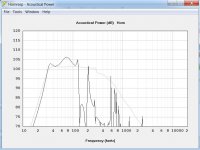
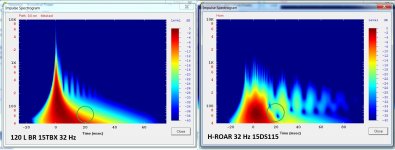
When adjusting the HROAR to have the same 32 Hz tuning as the BR I think my HROAR comes out on top again.
The wider area of red is indicative of a bandpass design and its slightly resonant series tuning. But the orange to yellow area circled in green (-8 to -16 dB) decays much faster in my HROAR then the BR. The BR has a lot of energy slowly decaying up to about 36 ms. The HROAR is essentially quiet after 20 ms, with only some lingering echoes in the front Helmholtz resonator chamber.
The first spike in the BR graph is the direct radiation from the driver.
The long and slowly decaying low frequency rumble (-8 to -16 dB) is the port in the BR.
The long and slowly decaying echoes from the Helmholtz front chamber of my HROAR is high frequency echoes at -20 to -22 dB @ 35 ms.
I prefer -20 dB @ 200 Hz to -10 dB @ 50 Hz after 35 ms.
Please ! You didn't even filtered the BR !
And eq equal !...reference level 0db in red for Roar sim is @80hz @ +6db... so it gives the impression everything else is at lower level !
And what you circled in Roar sim is nulling effect from resonnance !!!!
You'll see that if you EQ equal, you'll get exactly the same spectrogram ! What i mean is that ROAR problem is a response curve problem. And if you cure it, ROAR will probably no more have what you find so awesome in it...
And the effect seeing low range going to the right, it is not at all resonnance, it is just the group delay, and is expected !! It's not on your eyes symetric because it's not a visually linear phenomena, that's all....
You mis-analyse everything ! (and i'm a expert ^^)
EDIT : you compared to a 120 liters BR !? are you serious ! 15DS115 is not at all suitable for a bass reflex with a 0,17 qts !
And eq equal !...reference level 0db in red for Roar sim is @80hz @ +6db... so it gives the impression everything else is at lower level !
And what you circled in Roar sim is nulling effect from resonnance !!!!
You'll see that if you EQ equal, you'll get exactly the same spectrogram ! What i mean is that ROAR problem is a response curve problem. And if you cure it, ROAR will probably no more have what you find so awesome in it...
And the effect seeing low range going to the right, it is not at all resonnance, it is just the group delay, and is expected !! It's not on your eyes symetric because it's not a visually linear phenomena, that's all....
You mis-analyse everything ! (and i'm a expert ^^)
EDIT : you compared to a 120 liters BR !? are you serious ! 15DS115 is not at all suitable for a bass reflex with a 0,17 qts !
Last edited:
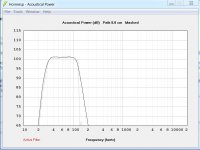
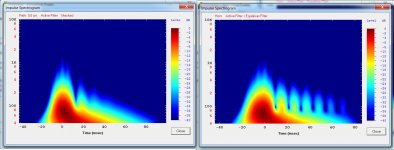
Close enough for government work.
I still see my HROAR coming out on top.
48 dB/octave @ 25 Hz and 120 Hz.
I EQed away the midbass peak of my HROAR.
The HROAR still have more and longer decay -20 dB 100 - 200 Hz content but the BR have a longer -10 dB low frequency decay (port resonance).
None of this shows the wave form reproduced when the driver is fed a bandwidth limited transient or other nonlinear non-sinuoidal signal...
...delay...BR is overall "printed/centered" spectrogram with more time delay by hornresp. It's overall more on the right.
The red 0db energy is centered on the right of the 0ms mark for the bass reflex, but to the left for roar. It's just a 5ms artifact delay... look closer.
The red 0db energy is centered on the right of the 0ms mark for the bass reflex, but to the left for roar. It's just a 5ms artifact delay... look closer.
Last edited:
- Status
- Not open for further replies.
- Home
- Loudspeakers
- Subwoofers
- Ported sub with good transient response
